Raytheon (General Dynamics) FIM-92 Stinger
The FIM-92 Stinger replaced the FIM-43 Redeye as the standard Western MANPADS (Man-Portable Air-Defense System), and is now very widely used in many countries of the world.
Development of the Stinger began in 1967 as a study for an improved FIM-43 Redeye, named Redeye II. The main improvement was to give the missile an all-aspect seeker capability. In 1971, the U.S. Army selected Redeye II for development as the future MANPADS, and assigned the designation FIM-92. In March 1972, the Redeye II was renamed as Stinger. Testing of guided XFIM-92A rounds began in November 1973, but was halted and restarted several times because of technical problems. By 1975, the most severe problems had been solved, and in July that year, the first shoulder launch of an XFIM-92A occurred. Finally, in April 1978, General Dynamics was awarded the first contract for mass production of the FIM-92A missile. Production Stinger missiles then replaced the old FIM-43 Redeye rounds on a one-to-one basis. IOC (Initial Operational Capability) was reached by the first Stinger units in 1981.
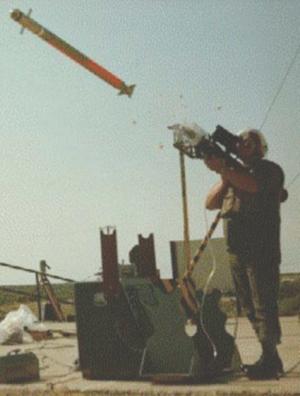 |
| Photo: U.S. Army |
| XFIM-92A |
The FIM-92A is fired by one man through a shoulder launcher. Once a target is located and identified as a threat, the operator has to activate the missile. This process takes about 6 seconds, and includes IR seeker cooling, gyro spin-up, and activation of the electronics. When the detector logic has locked on an IR source, a buzzer signal is sent to the operator, who may then pull the trigger. 1.7 seconds later, the FIM-92 missile is launched. After the Stinger has been ejected from the launcher by a very short duration boost motor, the forward control fins and fixed tailfins extend. After a short coasting period to take the missile to a safe distance from the operator, the two-stage (boost/sustain) solid-fueled main motor ignites. The initial boost phase accelerates the Stinger to Mach 2.2 within only 2 seconds, and top-speed at motor burnout can be as high as Mach 2.6 for certain trajactories. If no target is hit after about 17 (± 2) seconds, the missile self-destructs.
The Stinger has two major advantages over the older FIM-43 Redeye. The first is the second-generation cooled conical-scan IR seeker, which offers all-aspect detection and homing capability. Therefore, the Stinger can be used on approaching aircraft, before these had a chance to drop their short-range ordnance or begin ground-strafing. The second new feature of Stinger is its integrated AN/PPX-1 IFF system, which is an obvious advantage in a scenario where both friendly and enemy forces are operating aircraft. In flight, the missile's seeker head and guidance electronics can follow a target manoeuvering at more than 8g. In the immediate vicinity of the target, the guidance logic will be biased so that the missile homes on a particularly vulnerable part of the target (e.g. the cockpit of an aircraft, instead of the center of its IR signature, the jet exhaust). The 3 kg (6.6 lb) blast-fragmentation warhead is triggered by a proximity and time-delayed impact fuze. Minimum effective range is quoted as 200 m (660 ft).
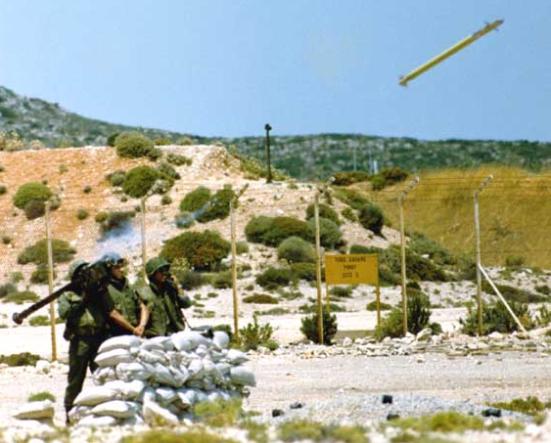 |
| Photo: U.S. Army |
| FIM-92A |
In 1977, General Dynamics had begun full-scale development of a next-generation Stinger, designated XFIM-92B. This missile, also known as Stinger-POST (Passive Optical Seeker Technique), has a new microprocessor-controlled two-band (IR/UV) seeker head. The POST seeker uses rosette-pattern image scanning techniques, which, together with new UV option, allows it to distinguish more efficiently between the real target and IR decoys or background clutter. The FIM-92B was placed in limited production in 1983, alongside the continuing production of the FIM-92A Basic Stinger. FIM-92A/B production finally ended in 1987 after more than 16000 rounds.
In 1984, development of the FIM-92C Stinger-RMP (Reprogrammable Microprocessor) began. The RMP upgrade allows reprogramming the on-board microprocessors' software to counter the latest threats. Stinger production switched to the FIM-92C in September 1987, and the first production Stinger-RMP missiles were delivered to operational U.S. Army units in July 1989. The designation FIM-92D applies to upgraded FIM-92Cs with improved countermeasures. In September 2002, the designation FIM-92G was allocated to an upgraded FIM-92D, but no details on the upgrade are available.
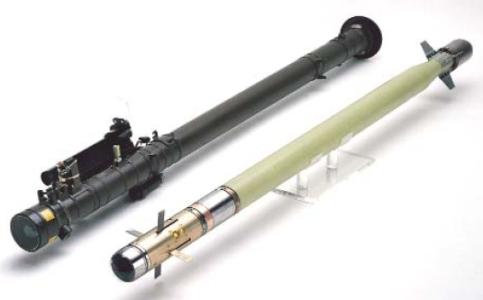 |
| Photo: Raytheon |
| FIM-92 and launcher |
In April 1992, a contract was awarded to General Dynamics for the development of the FIM-92E, known as Stinger-RMP Block I. Later that year, GD's missile division was sold to Hughes, which therefore became prime contractor for the Stinger system. The FIM-92E is an improved FIM-92D, and adds a new roll sensor and improved software, which significantly enhances the missile's performance against low-signature targets and the latest countermeasures. The first production FIM-92E missiles were delivered in 1995. Many existing FIM-92 missiles will probably be upgraded to FIM-92E standard. The designation FIM-92F was allocated in 2001 to an upgraded FIM-92E, but specific details about the improvements are not available. The designation FIM-92H refers to FIM-92D missiles, which have been upgraded to RMP Block I standard.
The latest Stinger development, approved for development in 1996, is the Stinger-RMP Block II, also known as Advanced Stinger. It replaces the IR seeker with an FPA (Focal Plane Array) IIR (Imaging Infrared) seeker, which increases detection range and accuracy especially in high clutter and countermeasures environments. The higher detection range increases the effective range to the Stinger missile's kinematic range of about 8000 m (26000 ft). The Block II had reached the EMD phase, but U.S. Army funding for production was eventually cancelled around 2002. At that time, the program had already been at least five years behind schedule.
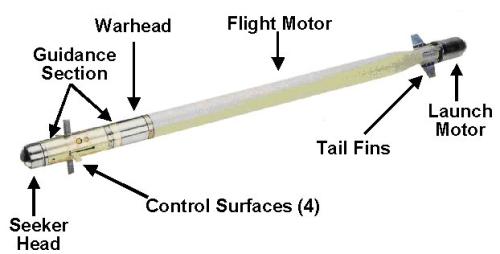 |
| Drawing: Raytheon |
| FIM-92 |
The current prime contractor for the Stinger MANPADS is Raytheon, which has acquired Hughes' missile division. The Stinger system has been sold to many forces around the world, including third-world countries (to the latter sometimes through "unofficial" channels). The system was heavily used by Afghan fighters during the Soviet invasion in their country, and up to 250 Soviet fixed-wing aircraft and helicopters are said to have been shot down by Stingers. In total, about 300 shoot-downs world-wide are attributed to the Stinger. Up to 2001, more than 70000 FIM-92 missiles of all variants have been built, including foreign production. The current production version is the FIM-92F Stinger-RMP Block I missile.
Beginning in 2014, the U.S. Army began to upgrade existing FIM-92E rounds to the FIM-92J standard. The -92J upgrade extends the service life of the Stinger by replacing older missile components, including the target detection device, the fuzing system and the rocket motor. The new fuze includes a proximity mode, which optimizes the performance of the FIM-92J against small targets like UAVs. If the missile's guidance electronics determine, that a direct hit on the target is improbable, the warhead is detonated at closest proximity. The FIM-92K is a derivative of the FIM-92J, optimized for use with vehicle-based launchers. It has different electricity and cooling interface ports, to connect to the vehicle's systems instead of the man-carried launch tube. It also adds a datalink to the missile, so that the launching vehicle can actively update the missile's targeting information with data from its own target detection and tracking systems.
The designation FIM-92L is mentioned in official documents covering an FMS (Foreign Military Sale) program for India, but no specifics about the -92L variant are available.
Designation Notes: Although sources [3] and [4] (and many others) attribute the designation FIM-92D to the Stinger-RMP Block I variant, this is incorrect according to first-hand source [5]. As of 2024, the designations FIM-92J, -92K and -92L are not included in DOD's official MDS designation listings, even though they are widely used in official military and DOD documents.
Other Systems Using the Stinger Missile
The FIM-92 Stinger missile is a very versatile weapon, and is not only used in its original man-portable role, but also as the missile component of other air-defense systems.
ATAS (Air-to-Air Stinger): The U.S. Army is using the Stinger missile (mainly FIM-92C/D Stinger-RMP models) as a helicopter-launched air-to-air missile. The ATAS is used by the OH-58C/D Kiowa, the AH-64 Apache, and will also be carried by the forthcoming RAH-66 Comanche. The designation AIM-92 is sometimes quoted for the ATAS, but this is most probably unofficial. As far as I am aware, the ATAS missiles are still known as FIM-92.
Avenger: In the early 1980s, the U.S. Army searched for a highly mobile forward area line-of-sight air-defense system. In September 1983, Boeing proposed the Avenger system, which was an M998 HMMWV (High Mobility Multipurpose Wheeled Vehicle, generally known as "Humvee" or "Hummer") equipped with a missile/gun turret. The turret had a .50 caliber M3P machine gun, and two missile launchers for four Stingers each. After comparative tests with other systems in 1985/86, Boeing was awarded a production contract for Avenger in August 1987. In April 1989, a first operational U.S. Army unit was equipped with the Avenger, and in April 1990, full-scale production of the system was approved. A single Avenger vehicle is manned by a two-man crew, and can be used against fixed-wing aircraft and helicopters at low altitude, day and night, and in all weather. The Avenger can use all variants of the Stinger missile.
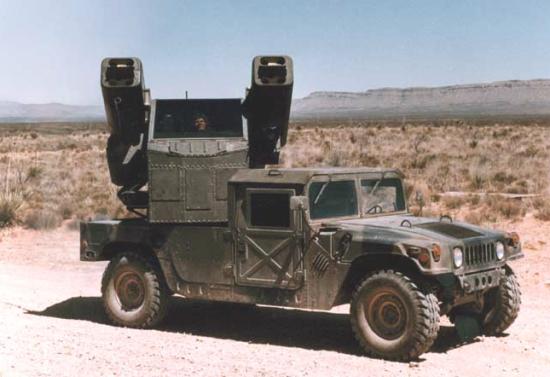 |
| Photo: U.S. Army |
| Avenger |
BSFV (Bradley Stinger Fighting Vehicle): The M2A2 BSFV was a derivative of the M2 Bradley Fighting Vehicle (BFV), equipped with inside-mounted racks holding Stinger missiles, and MANPADS operators to fire them. The BSFV was adopted by the U.S. Army as an interim weapon after procurement of the MIM-146 ADATS (Air-Defense Anti-Tank System) was cancelled. A drawback of the BSFV was the fact that MANPADS teams had to exit the vehicle before missiles could be fired. In the late 1990s, an improved version, the M6 Linebacker, was developed. This replaces the Bradley's TOW-launcher with a four-missile Stinger launcher, allowing fully mobile use of the missiles. Linebacker vehicles will be equipped with the latest FIM-92D/E Stinger-RMP rounds.
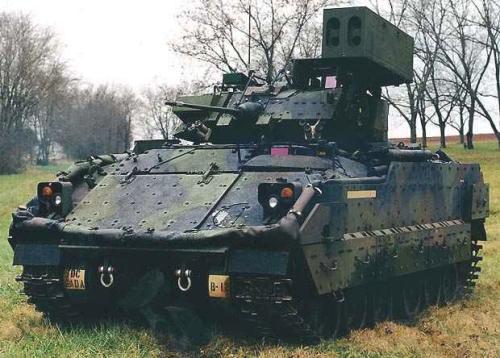 |
| Photo: Boeing |
| M6 Linebacker |
M-SHORAD (Maneuver-Short Range Air Defense): In 2018, the U.S. Army announced that it would modify some Stryker armored vehicles to an interim M-SHORAD configuration. Among the various air-defense systems of the M-SHORAD Stryker, are two Stinger Vehicle Universal Launcher (SVUL) units, for 4 missiles each. The first systems were delivered in April 2021. In 2024, the M-SHORAD Stryker was renamed as SGT Stout.
Specifications
Note: Data given by several sources show slight variations. Figures given below may therefore be inaccurate!
Data for FIM-92C (except where noted):
| Length | 1.52 m (5 ft) |
| Finspan | 9.1 cm (3.6 in) |
| Diameter | 7 cm (2.75 in) |
| Weight | 10.1 kg (22.3 lb); complete system: 15.7 kg (34.7 lb) |
| Speed | Mach 2.2+ |
| Ceiling | 3800 m (26200 ft) |
| Range | 4800 m (15700 ft) RMP Block II: 8000 m (26000 ft) |
| Propulsion | Atlantic Research MK 27 dual-thrust (boost/sustain) solid-fueled rocket motor |
| Warhead | 3 kg (6.6 lb) blast-fragmentation |
Main Sources
[1] Bill Gunston: "The Illustrated Encyclopedia of Rockets and Missiles", Salamander Books Ltd, 1979
[2] Christopher Chant: "World Encyclopaedia of Modern Air Weapons", Patrick Stephens Ltd., 1988
[3] Hajime Ozu: "Missile 2000 - Reference Guide to World Missile Systems", Shinkigensha, 2000
[4] Jane's Website:
"Raytheon
Electronic Systems FIM-92 Stinger", Jane's, 2000
[5] E-Mail from Jennifer Allen, Stinger Customer Communications, Raytheon Company, November 2002
[6] The National Interest, Charlie Gao: This Stinger
Missile Is Back, May 2018
Back to Current Designations Of U.S. Unmanned Military Aerospace Vehicles
Back to Directory of U.S. Military Rockets and Missiles
Last Updated: 15 December 2024